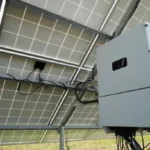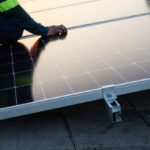Eco-Friendly Energy: A Breakdown of Solar Panel Types and Their Uses
As the world shifts towards sustainable and renewable energy sources, solar panels have become a popular choice for homeowners and businesses alike. Solar panels harness the sun’s energy to generate electricity, reducing reliance on fossil fuels and lowering greenhouse gas emissions. However, not all solar panels are created equal.
1. Monocrystalline Solar Panels
Characteristics:
- Efficiency: Monocrystalline panels are known for their high efficiency, often exceeding 20%. This is because they are made from single-crystal silicon, which allows electrons to move more freely.
- Appearance: They have a distinct black color and a uniform look due to the high-purity silicon used.
- Durability: These panels are long-lasting and usually come with warranties of 25 years or more.
- Area: Urban environments where aesthetics and space efficiency are important.
Uses: Monocrystalline panels are ideal for residential and commercial installations where space is limited but high efficiency is required. Their sleek design also makes them aesthetically pleasing for rooftop installations.
2. Polycrystalline Solar Panels
Characteristics:
- Efficiency: Slightly less efficient than monocrystalline panels, with efficiency rates around 15-17%. They are made from silicon crystals melted together, which creates a multi-crystal structure.
- Appearance: These panels have a blue, speckled look due to the different crystals in the silicon.
- Area: Solar farms and commercial installations where space is plentiful and cost is a factor.
Uses: Polycrystalline panels are suitable for installations where space is not a major constraint. They are often used in residential settings and larger solar farms due to their lower cost.
3. Thin-Film Solar Panels
Characteristics:
- Efficiency: These panels have lower efficiency rates, typically between 10-12%. They are made by depositing one or more layers of photovoltaic material onto a substrate.
- Flexibility: Thin-film panels are lightweight and flexible, which opens up a range of installation possibilities.
- Appearance: They have a uniform, black appearance and are less obtrusive than other types of panels.
- Area: Buildings with non-standard roof shapes or surfaces, portable applications, such as solar backpacks, mobile homes, or camping gear.
Uses: Thin-film panels are ideal for situations where traditional panels are impractical. They can be integrated into building materials, such as windows and roofing, and are excellent for portable applications, like solar-powered backpacks.
4. Bifacial Solar Panels
Characteristics:
- Efficiency: These panels can capture sunlight from both sides, increasing overall energy production. They often have efficiency rates similar to monocrystalline panels.
- Design: Bifacial panels are typically made with a transparent back sheet or dual glass, allowing light to enter from both the front and back.
- Durability: Highly durable and designed to withstand harsh weather conditions.
- Area:
Uses: Bifacial panels are great for open spaces where reflected sunlight from surfaces like the ground, water, or snow can be utilized. They are commonly used in solar farms and commercial installations.
5. PERC Solar Panels (Passivated Emitter and Rear Cell)
Characteristics:
- Efficiency: PERC technology enhances the efficiency of monocrystalline and polycrystalline panels by adding a passivation layer in the rear, which reflects light back into the cell.
- Performance: These panels perform better in low-light conditions and high temperatures compared to traditional panels.
- Area: Regions with hot climates where traditional panels might lose efficiency. Locations with inconsistent sunlight, ensuring better performance in varied conditions.
Uses: PERC panels are suitable for residential, commercial, and utility-scale installations where high efficiency and performance are critical, especially in areas with variable weather conditions.
Conclusion
Choosing the right type of solar panel depends on various factors, including budget, space availability, and specific energy needs. Monocrystalline panels offer high efficiency and durability for limited spaces, while polycrystalline panels provide a cost-effective solution for larger installations. Thin-film panels offer flexibility and integration options, bifacial panels maximize energy capture, and PERC panels enhance performance in challenging conditions. By understanding the characteristics and best uses of each type, you can make an informed decision that aligns with your sustainability goals and energy requirements.
Investing in solar panels not only contributes to a greener planet but also provides long-term financial benefits through reduced energy costs. As technology advances, the options for harnessing solar energy will continue to expand, making it easier for everyone to participate in the renewable energy revolution.



